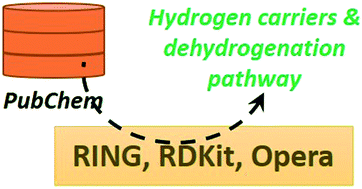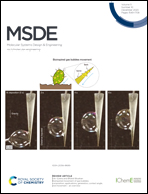A computational workflow to discover novel liquid organic hydrogen carriers and their dehydrogenation routes†
Abstract
Two-way liquid organic hydrogen carriers (LOHC) – organic molecules that store hydrogen as reversible chemical bonds – is an emerging concept for on-demand storage and transportation of hydrogen (and thereby energy). Given the large chemical universe, a plethora of potential LOHCs exist, however, the optimal candidate depends on satisfying a variety of constraints on physicochemical and thermochemical properties. Computational high-throughput screening of a subspace of this universe can, in principle, reveal several LOHC candidates which can then be experimentally verified; however, to achieve this, the hydrogen rich and lean forms of the LOHC pair have to be simultaneously identified based on a plausible connecting chemical pathway. Here, using a combination of data-driven molecular property models and a cheminformatics-based reaction network generation tool, viz. RING, we develop a novel computational workflow to identify promising LOHC pairs (i.e. hydrogen-rich and hydrogen-lean forms) and the dehydrogenation pathways connecting them. Starting from over 1 million small (containing less than 14 heavy atoms) molecules in the PubChem database as seed, we applied this framework as proof of concept to identify several LOHC pairs that have promising properties in terms of melting point, boiling point, dehydrogenation enthalpy, hydrogen storage capacity, and synthetic accessibility; we further analyze the thermochemistry of dehydrogenation pathways of the top five candidates. We finally show that this screening provides a rich dataset that can be harnessed via supervised learning algorithms to infer descriptive features that determine if a molecule is a good LOHC candidate. We posit that the proposed workflow can be used to scalably analyze a much larger molecular space and multiple classes of dehydrogenation chemistries to discover novel LOHC pairs.



 Please wait while we load your content...
Please wait while we load your content...